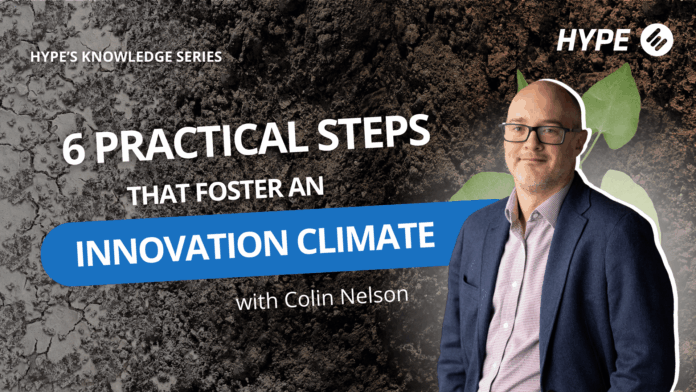Lessons from Colin Nelson’s Knowledge Session on building an environment where innovation thrives.
What if your organization didn’t just “support” innovation — what if leadership actively created the conditions for it to succeed? In a focused knowledge session, Colin Nelson (Chief Innovation Consultant, HYPE) explored how leaders can move beyond rhetoric and put practical structures in place to make innovation repeatable, visible and valued across the company. Use the summary for a fast read; watch the recording above for the full discussion, Q&A and real-world case examples.
Below we distill Colin’s core arguments and provide an actionable checklist you can use to start improving your innovation climate today.
Why climate matters — and what’s at stake
Employees are less engaged than ever; Gallup’s 2024 data shows global engagement levels are down to 21%, and many companies feel the effects in participation and discretionary effort. Colin notes that when people don’t believe the organization is investing in the right things, or when they feel unheard, their willingness to contribute creative effort drops dramatically. But the good news: climate is changeable. When organizations get the environment right, participation and outcomes improve — sometimes dramatically.
The six leadership behaviors that create a thriving innovation climate
Colin focuses on six practical leadership activities, based on the ISO 56000 family standards for innovation management— things leaders can realistically adopt to shift climate and unlock collective intelligence:
-
Adopt a portfolio approach
Balance short-term wins, growth plays and long-term bets so employees see that all horizons matter. This reduces short-termism and demonstrates a credible route to future growth.
Protect funding across innovation segments
Ring-fence funding for incremental, adjacent and radical initiatives so short-term pressures don’t continuously cannibalize future investments. Make budget allocation a governance conversation rather than a last-minute scramble.
-
Measure the right things (and consistently)
Use a minimal set of “minimum viable innovation measures” — e.g., capacity invested, forecasted impact, time-to-value and a judged likelihood of success — applied consistently across the portfolio to enable fair comparisons and merit-based decisions. -
Bring independent assessment to likelihood judgments
Don’t rely solely on the concept owner’s optimistic estimate. Use independent reviews, head-to-head comparisons, or even prediction markets to get unbiased assessments of a concept’s likelihood of success. These methods reduce bias and improve portfolio decisions. -
Make gate reviews collaborative and supportive
Reframe gate reviews from adversarial “go/no-go” interrogations to “How can we help make this better?” sessions — provide access to expertise, partners, or funding to accelerate promising concepts rather than simply shutting them down. -
Recognize and reward good process (not just outcomes)
Celebrate rigorous process, learning, and effort as well as final successes. Recognize milestones, “learning deposits,” and the behaviors you want to see—curiosity, courage and humility—otherwise people will chase only the rare visible wins. For example, Tata’s Innovista program includes a “Dare to Try” category that publicly rewards bold experiments (even those that don’t immediately succeed), shifting incentives toward disciplined experimentation and faster organizational learning.

Practical examples & evidence
Colin shared examples and research from practice: some organizations see engagement rates as high as 80% when they run mature enterprise innovation programs supported by advocacy, communications and recognition; other organizations that lack structure struggle to get consistent results. He also referenced historical uses of prediction markets (e.g., Xerox) to illustrate how crowd-based forecasting can dramatically improve likelihood estimates.
Quick action checklist (for leaders)
✅ Set a portfolio conversation: Run a one-hour portfolio framing meeting with the governance board to align horizons and risk appetite.
✅ Ring-fence seed funding: Allocate small protected pools for pilots and exploratory bets so short-term budgets don’t kill future options.
✅ Agree 4–6 baseline measures: Choose consistent metrics (capacity, forecast impact, time horizon, likelihood) and apply them to all concepts.
✅ Introduce independent likelihood checks: Pilot a small head-to-head review or internal prediction market for 10–15 concepts.
✅ Reframe gate reviews: Train gate members to ask “how can we help?” and identify resources or partners at each gate.
✅ Reward the right behaviors: Create micro-recognition for process milestones and learning deposits, not only launches.
How this lifts engagement and performance
When companies implement these steps, three things happen:
- Decisions become more merit-based
- Innovators feel safer and more valued
- Leadership gains visibility and confidence in the portfolio.
That combination produces faster learning, higher-quality ideas, and better alignment between strategy and execution.
Want to go deeper?
If you’d like Colin’s help applying these ideas to your organization, HYPE offers a free consultation and a short Innovation Management Assessment to benchmark maturity and identify prioritized next steps. Book a session with our team or request a demo to see how these governance and measurement concepts can be operationalized in a single system of record.


